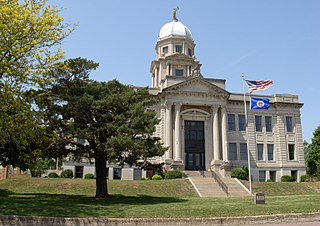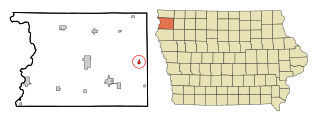Related Research Articles

Clay County is a county located in the U.S. state of Iowa. As of the 2020 census, the population was 16,384. Its county seat is Spencer. Its name is in honor of Henry Clay Jr., a colonel who died in action in the Mexican–American War, and son of Henry Clay, famous American statesman from Kentucky.

Nobles County is a county in the U.S. state of Minnesota. As of the 2020 census, the population was 22,290. Its county seat is Worthington. Nobles County comprises the Worthington, MN Micropolitan Statistical Area.

Jackson County is a county in the U.S. state of Minnesota. As of the 2020 census, the population was 9,989. Its county seat is Jackson.

Faribault County is a county in the U.S. state of Minnesota. As of the 2020 census, the population was 13,921. Its county seat is Blue Earth.

Cottonwood County is a county in the U.S. state of Minnesota. As of the 2020 census, the population was 11,517. Its county seat is Windom.

Sioux County is a county located in the U.S. state of Iowa. As of the 2020 census, the population was 35,872. Its county seat is Orange City. Its largest city is Sioux Center.

O'Brien County is a county in the U.S. state of Iowa. As of the 2020 United States Census, the population was 14,182. The county seat is Primghar.

Floyd County is a county located in the U.S. state of Iowa. As of the 2020 census, the population was 15,627. The county seat is Charles City.

Underwood is a town in Pottawattamie County, Iowa, United States. The population was 954 at the time of the 2020 census.

Hospers is a city in Sioux County, Iowa, United States, along the Floyd River. The population was 718 at the time of the 2020 census.

Hull is a city in Sioux County, Iowa. The population was 2,384 at the time of the 2020 census.

Orange City is a city in, and the county seat of, Sioux County, Iowa, United States. Its population was 6,267 in the 2020 census, an increase from 5,582 in 2000. Named after William of Orange, the community maintains its Dutch settler traditions visibly, with Dutch storefront architecture and an annual Tulip Festival.

The Spirit Lake Massacre was an attack by a Wahpekute band of Santee Sioux on scattered Iowa frontier settlements during a severe winter. Suffering a shortage of food, the renegade chief Inkpaduta led 14 Sioux against the settlements near Okoboji and Spirit lakes in the northwestern territory of Iowa near the Minnesota border, in revenge of the murder of Inkpaduta's brother, Sidominadotah, and Sidominadotah's family by Henry Lott. The Sioux killed 35-40 settlers in their scattered holdings, took four young women captive, and headed north. The youngest captive, Abbie Gardner, was kept a few months before being ransomed in early summer. It was the last Native American attack on settlers in Iowa, but the events increased tensions between the Sioux and settlers in the Minnesota Territory. Nearly 30 years after the events, in 1885 Gardner-Sharp published her memoir, History of the Spirit Lake Massacre and Captivity of Miss Abbie Gardner, which was reprinted several times in small editions. It was one of the last captivity narratives written of European Americans' being held by Native Americans. In 1891, Gardner-Sharp purchased the primitive family cabin and returned home. For the last 30 years of her life, she subsisted on the modest earnings from her book and souvenir sales. The town erected a historical monument to commemorate the attack. The State of Iowa now maintains the park and Abbie Gardner Sharp home site.
Levey Township is a township in Sac County, Iowa, USA. Part of Wall Lake is within Levey Township.
Sioux Township is a township in Monona County, Iowa, USA.
East Orange Township is a township in Sioux County, Iowa, USA.
Grant Township is a township in Sioux County, Iowa, USA.
Holland Township is a township in Sioux County, Iowa, USA.
Lynn Township is a township in Sioux County, Iowa, USA.
Eureka Township is a township in Sac County, Iowa, United States. Schaller, Iowa is contained within Eureka Township.
References
- ↑ U.S. Geological Survey Geographic Names Information System: Floyd Township, Sioux County, Iowa
- ↑ "County Subdivision: Floyd Township, Sioux County, Iowa". United States Census Bureau. Retrieved 17 December 2022.
- ↑ "Floyd Township Cemetery". Google Maps. Retrieved 17 December 2022.
- ↑ Beltman, Brian (1996). Ethnic Territoriality and the Persistence of Identity: Dutch Settlers in Northwest Iowa, 1869-1880. The Annals of Iowa 55 (PDF). State Historical Society of Iowa. p. 116. ISSN 0003-4827 . Retrieved 17 December 2022.
- ↑ Dyke, Charles L (1943). The Story of Sioux County. Orange City, Iowa. p. 65.
- ↑ Beltman op cit p. 119-120.
Coordinates: 43°02′N95°55′W / 43.033°N 95.917°W
